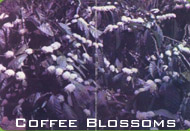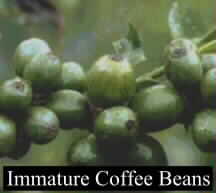 Coffee
-The World's Favourite Beverage. Many millions of people around the globe can't
get through the day without their morning cuppa. Critisised as addictive, praised
as a pick-me-up, Coffee has taken many forms - cold coffee, coffee in a toffee,
etc etc. It can be bought in many forms too - chicory blend, filter and so on.
Coffee
-The World's Favourite Beverage. Many millions of people around the globe can't
get through the day without their morning cuppa. Critisised as addictive, praised
as a pick-me-up, Coffee has taken many forms - cold coffee, coffee in a toffee,
etc etc. It can be bought in many forms too - chicory blend, filter and so on.
Indian coffee today is acknowledged as one of the finest mild coffees in the world. With the tropical climate, high altitude, sunny slopes, good rainfall and rich soils India has consistently produced and exported high quality coffees for over 150 years. Indian coffees are noted for their blue color, cleanness of beans and fine liquoring qualities. These qualities also add richness, strength and flavors to the coffee. Coorg, situated at a height of 3500 feet above sea level and ideally suited for coffee growing. Coorg s coffee estates produces some of the World s best coffees with a variety of plants like Arabica & Robusta .Besides coffee, the other potential interplantation crops are cardamom, pepper, oranges & cocoa. A variety of trees like rosewood, teakwood, silver oak, firewood etc., are grown along with coffee. Coffee needs lots of rainfall, altitude, steep terrain etc. to flourish. All these conditions are satisfied in Coorg and coffee grows naturally here. Karnataka state is the largest exporter of coffee in India and Coorg contributes to 80% of Karnataka's coffee exports.
Arabica and Robusta are exported in the following grades -
![]() ARABICAS
:
ARABICAS
:
Plantation A - Plantation PB - Plantation B - Plantation C - Plantation Bulk - Arabica Cherry PB - Arabica Cherry AB - Arabica Cherry C - Arabica Cherry Bulk.
![]() ROBUSTAS :
ROBUSTAS :
Parchment AB - Parchment PB - Parchment C - Parchment Bulk - Robusta Cherry AB - Robusta Cherry PB - Robusta Cherry C - Robusta Cherry Bulk.
The Plantation Story -
How Coffee goes from seedling to sapling to everyone's favourite beverage :
Coffee is a cash crop. Coffee growing is classified as an industry ; And as in any industry, every coffee estate's basic requirements can be classified under the five M's - Materials, Machines, Men, Management & Money.Coffee being an industry doesn't do away with the fact that it's basic needs are are the same as any crop and depend largely on the climatic conditions, weather, altitude, water etc. the location of a coffee estate is chosen based on the rainfall, elevation, proximity to water & availability of labour. Seeds are the other basic raw materials for an estate. The seed materials are selected from the same estate or from neighbouring estates which have the same climatic conditions. The seedlings are selected from high yeild and high disease resistant varities. These seedlings are used to raise the nursery to the requirements of the estate. An estate of appreciable size, say 300 acres may raise upto 1 ? lakh seedlings.The best seedlings are chosen after they are 1 to 2 years old and transplanted in the estate. the seedlings start yeilding after 3 years, but are not allowed to. they attain full bloom after 5 years (Arabica, 6 years for Robusta).
Arabica is grown at elevations between 3000 and 6000 feet whereas Robusta is grown at lower elevations. Arabica is characterized by smaller leaves & stem. With respect to taste, it is milder and is preferred for export purposes. Arabica is costlier and is generally used for blending. Robusta plants are comparatively larger with broader leaves and thicker stem. It makes for a stronger blend and require very little maintenance, if any. Arabica matures earlier but Robusta plants have a much lengthier life span when compared to Arabica.

Initial showers before the monsoon, called the blossom showers are required for the coffee blossoms to grow. For supplementing blossom showers, sprinkler irrigation systems are used. Drip irrigation systems using electrically operated motors, diesel pumpsets are used for yeilding coffee, intercrops etc. Power sprayers are used (Bourdeux, Folier) for preventing fungi growth in Arabica. Tractors are used for hauling harvested coffee, timber and for ploughing paddy fields. Maintenance of coffee requires regular weeding, pruning of coffee plants, fertlizer application, shade lopping etc. Coffee requires shade to grow properly. Too much sunlight can be harmful to the plant. The trees planted for shade, besides being a souce of timber, are also used for growing black pepper. Sometimes Cocoa trees are also planted. Other crops are interplanted along with coffee. The most common intercrops are - Orange, Pepper and Cardamom.
Cardamom is the crop that gives the best returns. cardamom harvesting can take upto five months. One labourer harvests around 1Kg a day. 5000 capsules come up to 1 Kg. Cardamom can yeild around 100 Kg per acre. It is then dried at 55 deg.celsius in drying rooms to remove the moisture. Pepper is grown on the shade trees. Around 15 tonnes of pepper can be harvested from a 100 acre estate.
 The harvesting season starts in mid - November, when Arabica starts yeilding.
Harvesting of Arabica continues until mid - January. Robusta harvesting begins
in January and continues till March. So, the total harvesting season lasts for
5 months from November to March. Harvesting is completely labour dependent.
the labourers are not permanent employees but come partly from different groups
of floating populations. All the work has to be done by hand and is extremely
time consuming. All the ripe berries have to be picked before the season ends
otherwise they go bad. Due to this, each and every plantation is prepared to
pay higher prices to attract the labourers. Sometimes the wages being paid will
be equal to the value of the harvested crop ! Even though strikes are non-existent,
managing the worker's problems and making sure they turn up for work each day
and complete it is a herculean task. If one member of a family decides he's
not being treated well, the whole family, including their friends might decide
to work somewhere else ; or if a worker from one group has a misunderstanding
with a worker from another group, both groups might decide to quit work. To
overcome such problems, the labourers are provided with accomodation, provident
fund, bonus etc. Also, ther work is awarded on a contract basis so that they
can make extra money.
The harvesting season starts in mid - November, when Arabica starts yeilding.
Harvesting of Arabica continues until mid - January. Robusta harvesting begins
in January and continues till March. So, the total harvesting season lasts for
5 months from November to March. Harvesting is completely labour dependent.
the labourers are not permanent employees but come partly from different groups
of floating populations. All the work has to be done by hand and is extremely
time consuming. All the ripe berries have to be picked before the season ends
otherwise they go bad. Due to this, each and every plantation is prepared to
pay higher prices to attract the labourers. Sometimes the wages being paid will
be equal to the value of the harvested crop ! Even though strikes are non-existent,
managing the worker's problems and making sure they turn up for work each day
and complete it is a herculean task. If one member of a family decides he's
not being treated well, the whole family, including their friends might decide
to work somewhere else ; or if a worker from one group has a misunderstanding
with a worker from another group, both groups might decide to quit work. To
overcome such problems, the labourers are provided with accomodation, provident
fund, bonus etc. Also, ther work is awarded on a contract basis so that they
can make extra money.
 After harvesting, the coffee berries are graded
and the ripe red berries are seperated from the unripe green ones. Dirt and
foreign particles like twigs, stones, leaves are also removed. The ripe berries
are then sent for pulping. A machine called the aqua pulper/washer is used to
remove the mucus. it is then spread on a tiled drying yard where it is dried
to the specific ratio recomended by the coffee board. After this, it is cleaned
again and the dry husks are removed. It is then sent to a coffee curing plant.
After harvesting, the coffee berries are graded
and the ripe red berries are seperated from the unripe green ones. Dirt and
foreign particles like twigs, stones, leaves are also removed. The ripe berries
are then sent for pulping. A machine called the aqua pulper/washer is used to
remove the mucus. it is then spread on a tiled drying yard where it is dried
to the specific ratio recomended by the coffee board. After this, it is cleaned
again and the dry husks are removed. It is then sent to a coffee curing plant.
The Coffee Curing Plant is the final stage in the processing of coffee. the output of these plants is coffee as we know it, in it's various forms - Instant coffee, pea berry powder, chicory blend etc.
Trucks containing coffee from the estates arrive at the plant. The truck, along with the loaded coffee is weigh bridge, after which the coffee is unloaded and stored in the raw coffee godown. then, the trucks are weighed again and the difference gives the weight of the coffee unloaded.
It is then taken to the milling section. There, machines called stick & stone seperators process the coffee to remove the impurities like sticks and stones. Then comes the machine called a Huller. it is used to remove the outer skin of the coffee berries. Next in line is the pulper/polisher, for cherries, which removes the silver lining or the dried coffee berry skin.
The berries are then sent to the Winnower, which removes the loose husk and other debris, which are blown off. they do not go to waste though. they are in high demand as industrial fuels because of their good heat retention capability and cost effectiveness. This can be called a byproduct of the processing stage. The Graders then grade them into P-berries, AB1, and bits,cuts & blacks using sieves to seperate the different varities. Machines known as Catadors remove the remaining husks.
Then come the Electronic Colour Sorters, which work on the principle of the difference in wavelenght of light for different colours. Poor varities like the bits, blacks and cuts are not sent to the colour sorter, but used in making instant coffee. They are then weighed, bagged and exported. As for the others, after colour sorting is done, they are sent for Garbling - which is done manually by hand, mostly by women. This is the final sorting.
The finished products are stored in the clean coffee godown, from where they are sent to the markets for sale, after being weighed. They may be sold in the domestic market or sent for export, depending on the type and grade of coffee. Most milder coffees are exported. Instant coffee is also mainly exported.
The manager is the person responsible for
the estate and any major decision has to to through him; but the day to day
tasks are overseen by 'writers' to whom the manager delegates authority. Accounting
is done on a weekly basis - At the end of the week, all the bills are cleared
and the workers are paid their weekly wages. A coffee estate produces a lot
waste. Almost all of it is put to some use or the other. the wood resulting
from shade lopping is sold as firewood after taking permission from the forest
department. The coffee husks that are left over after pulping are used to
prepare organic manure and can be applied to the plantation itself. It can
also be used as alternative fuel in Industrial boilers. The major problem
affecting coffee at present is the berry borer, mainly in Robusta variety
and occasionly in Arabica. Berry borer is an insect that eats through the
coffee berries, ruining the crop. The pesticide is very expensive and this
problem is also affecting exports. In Orange, a fungal disease is damaging
the entire Orange growing industry in Coorg. Till now, nobody has come across
a working solution. Honey bee cultivation, which until recently was so sucessful
in Coorg is almost non-existent today because of a disease that affected all
the bees. Due to erratic weather conditions, crop shedding has also become
a severe problem recently, affecting all crops.

In a coffee plantation, if the total capital investment is broken down into 4 parts, 2 parts will go for the land, 1 for labour and the other for infrastructure. Capital is raised mainly by ploughing back the profits of selling agricultural produce into the estate and through banks. At present, the coffee industry is a high risk - high return investment prospect with very high prices for cultivated land, infrastructure, labour but balanced by equally high prices for Indian coffee, cardamom & pepper.The price of coffee in the world market is very volatile and is affected by evrything from the decisions of the Indian Coffee Board to frost in Brazil. Because of this, many plantations are diversifying into areas like silk farms & floriculture. The efforts have been sucessful so far with the floriculture products from Coorg already having made a name for themselves in terms of quality.
Acknowledgement : The Management - Dwaraka Estate, Madikeri, Coorg.
ravi.giri@gmail.com



